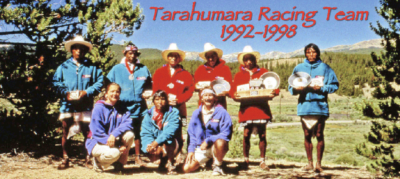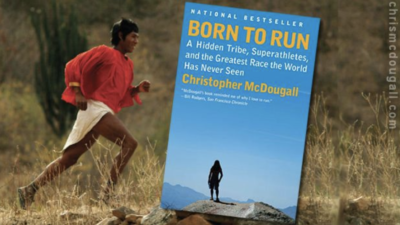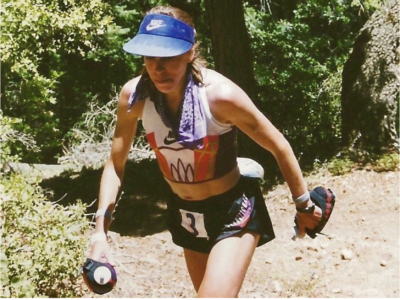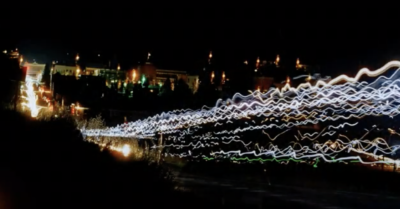With great beauty comes great responsibility. Given Leadville’s uniquely stunning panoramas and high-mountain trails, we…
Leadville Race Series History: The Unforgettable Story of the Tarahumara and Ann Trason
Leadville Race Series History: The Unforgettable Story of the Tarahumara and Ann Trason
Words by Cole Chlouber
By now many of you have heard of the famed Tarahumara and also know their history with The Leadville Trail 100. The Tarahumara or Rarámuri (also known as the running people) were just featured this past month on HBO’s 30 for 30 series, it’s a must see! It is possible you have not heard of the Tarahumara or their history with The Leadville Trail 100. If you have not, let me give you the quick history. In 1993 the Tarahumara were introduced to us as a very wild and timid group, super athletes if you will. But the one item that stood out to us all the most was how they’d chosen the athletes that were sent to represent them. The Tarahumara had chosen the kind elders of the group, not the fastest ones. That was always fascinating to us, in fact at the time we were introduced to the Tarahumara in 1993 it was said that their culture had not experienced a suicide or murder to date. Not a one.

Now, this first introduction the Tarahumara had with Leadville didn’t go as planned and they were by no means ready to tackle a 100 mile foot race. This was not the Tarahumara’s fault mind you, and it wasn’t because they lacked ability. Cultural limitations, language barriers and so much more were what was lacking. For instance, in the 1993 race Rockport had not yet got involved with the Tarahumara directly. Their manager at the time was in fear that their normal huarache style sandal might leave the sandals or runners injured from either the rugged topography of our rocky mountains or possibly render them hypothermic from the cooler temperatures from that of their home in the Copper Canyons of Mexico. Their manager tried to fit them into donated Converse All Star sneakers, needless to say the Tarahumara were found grabbing at their feet in pain only a few miles into the race, kicking the sneakers off for their traditional attire…or none at all as a few had left their sandals in town.
A few other items that were also against them? The list wasn’t long. Starting with trail markers and the fact that they’d never been taught to follow them for an actual race, running was a way of life for them, not the recreation it is for us. Many of the original Tarahumara were found wondering on and off the trail in exploration and fascination of each new vista, racing seemed to be the last thing on their mind. Second was the 4am start in the dark. Keep in mind that in 1993 there were no headlamps or good running lights invented yet, no, these runners were donning large orange lights housing two full size DD batteries like the ones used at the Climax Molybdenum Mine (because Climax was the one who donated the lights to them). It became quickly apparent that the Tarahumara had never run under any kind of light other than the moon. These lean mythical athletes were trotting off into the darkness with their lights pointing into the air and towards the heavens as if they were torches lighting their way. Other runners would try to run up and help show the Tarahumara how to point and use the lights more efficiently, but they were too quick to catch and those runners that could catch them were far too out of breath and couldn’t give a proper example once they caught up. Even if they had their breath there was still this little language barrier that we’ve touched on.
Next on this long list of barriers for these gentle athletes to participate in our American endurance foot races – tradition. In Tarahumara culture you do not take or eat food unless it is given to you. And as you can imagine, asking for food was going to be a challenge without being able to speak English. Both language and culture quickly become a problem for these hungry, foreign-tonged ultra runners as they approached the massive tables of food inside the aid stations in need of aid but too kind and humble to take anything without it being first offered to them. So we know they had many detours and didn’t eat. We already told you it didn’t go to plan. It also wasn’t anywhere near a total loss, in fact quite the opposite, which only makes these mythical super athletes more interesting.
So we’ve now learned that the Tarahumara didn’t keep the Chuck Taylors on, they didn’t stay on the trail (they added mileage taking in all the mountain vistas possible), they pointed their flashlights towards the heavens (rendering them useless), they didn’t take the aid station food. That is a list of misses that would take Rob Krarr into an unrecoverable deficit, so what did they do to see any kind of success in this unforgiving hard rock mining community?
They fueled with their normal corn based pinole for food and Tesgüino, a fermented drink made from sprouted corn and they ran. Yes, it is a type of beer. No, you probably can’t personally drink enough to get drunk. The Tarahumara have long-distance running traditions which contain both ceremonial and competitive aspects. Often, men kick wooden balls as they run in “foot throwing”, or rarajipari, competitions. The foot throwing races are relays where the balls are kicked by the runners and relayed to the next runner while teammates run ahead to the next relay point. These races can last a few hours to a couple of days without a break.
Remember: I said the Tarahumara’s first introduction didn’t go as planned. It still went very well for them as they finished 1, 2, and 5. Number 1 that year was 55 year old Victoriano Churro, followed 30 minutes later by 38 year old Cerrildo Chacarito. While spectacular, 11 minutes later came 46 year old past champion Steve Mahieu and a minute later the 1993 women’s champion, Christine Gibbons. Manuel Luna (30) was fifth in this running of the Leadville Trail 100. In 2006 Barefoot Ted McDonald was so inspired by what he’d witnessed that he set out to find Manuel Luna in hopes of learning how to make the traditional huarache barefoot running sandal, and that he did! In 2010 Barefoot Ted started Luna Sandals in Seattle Washington just blocks from the space needle. Today he and his wife Live sells them worldwide with quite a cult following, and still using Manuel’s sir name in homage to the company. Ted also uses his business to give back and is very humble and forward about the genius behind his company.
1994: Leveling the Playing Field
Fortunately, the Tarahumara were able to return the following year, and this time with better preparation. This time they were being trained by Kitty Williams, wife of their manager and daughter of one of our original and long-time Leadville finishers, Ed Williams. Kitty was twice a finisher of the race herself and was also able to communicate with the Tarahumara after having spent many of her college years studying indigenous people and communication. She had prepared them on lights, aid stations, what was culturally acceptable during an event of this nature, but most of all, she taught them to run the race, what it took to really compete and when the Tarahumara runners showed up for the 1994 running of the Leadville Trail 100 we were all going to see history unfold. We were all going to a front row seat paired with the chance to see what the Tarahumara could do with an even playing field, one they could understand. But as history was to unfold, one part of history would prove to be a history that none of us were expecting, this proved to be another one of those magical moments the world would lay witness to in Leadville on that August day in 1994.
In fact, it would later be this interaction with these mythical runners set high in the magical cloud city known as Leadville would send war time journalist Christopher McDougall on a detective case uncovering numerous colorful characters and revealing a love of donkeys along his search for these magical running people and the answers that made them known for an activity he himself could not do without enduring numerous amounts of pain on every outing. Along his journey he wrote the book “Born To Run” which almost instantly shot Christopher to the top of the New York Best Seller list and into a world of fame which he still credits to a late night talk show visit for the spark that lit such a fire. The book did such a great job of telling the Tarahumara’s story. In fact, it did such a great job that many shoe companies were left scratching their heads as they continued to develop what this book would call over-developed shoes. Almost overnight many of these shoe companies hit stop on current production and instantly were in development with their own versions of a shoe based around a movement produced by marketers scrambling to meet demand, calling the movement “minimalism” which is still widely used in the running shoe market today. I can’t recall running taking such a large stage since two Oregon guys put some rubber in a waffle iron, glued it to some material and started selling running shoes out of the trunk of their car. Oddly, this Nike Waffle Racer I am referencing is exactly the step back from technology the shoe companies took, ending on many models with a look similar to their roots.

In 1993 Rockport was starting a 3 year sponsorship as the headlining sponsor with the Leadville Trail 100 and the then VP of marketing for Rockport, Tony Post, was at the helm. He had run marathons in the company’s dress shoes at blistering paces, sub 3 hours in fact (!), and was set to put them on a new stage: Mountain biking. That’s right, Rockport, the shoe company, entered into the Leadville sponsorship asking for Leadville to host a 100 mile mountain bike race on the same day (and course) as the now 10 year old running event. And in this search Tony also had another interest: running shoes, also to debut at the 1994 Leadville Trail 100 Run. I think race founder Ken Chlouber’s answer to Tony wasn’t a simple no but more of a “Hell no!”
Ken, Merilee, Tony and the rest of the Rockport team eventually came to an agreement that this new idea of a mountain bike race was set to happen the week prior to the running race and Tony would now be on the hook to market these two ideas of his. We never did see that bike shoe come to fruition, but this idea that Tony had for a mountain bike race became one heck of a stroke of genius, one none of us saw the potential in like Tony did. In fact, pretty much anything Tony touches seems to see such success. And while there wasn’t a bike shoe offering from Rockport, Tony knew he had big opportunity here, opportunity to develop the type of running shoe he had in mind and use the partnership with the race and knowledge of the Tarahumara’s return to his advantage. Tony and Rockport did end up releasing the Rockport Leadville Racer, something that wouldn’t happen again until around 2012 when New Balance partnered with the Leadville Race Series, renaming their popular 1210 trail base shoe to the New Balance Leadville 1210. Funny enough, it was the perfect platform for the course, but it was far from a minimal offering. The Rockport shoe was also a solid middle-of-the-road offering.
While all of the above did not play into Tony’s hands exactly as he had planned, 1994 forever changed the face of running. And in the face of that change, one thing has gone virtually unnoticed. I absolutely do not want to take anything away from the Tarahumara did that day or what they did in 1993. The Tarahumara are very special people who were runners long before us and will be long after. They deserve their place in any running history and can only teach us.
What I do want to do is to take a pause to honor another champion among champions from that very same day, one the world did not expect and one that I feel has gone under celebrated, and in true romantic era fashion, meets Leadville’s history head-on.
It’s no secret that Leadville was founded on the backs of strong women. Strong women like the Unsinkable Molly Brown and Baby Doe Tabor, and the 1994 running of the Leadville Trail 100 was no different. This world of ultrarunning was relatively new and still forming. These running challenges were beyond marathon distance and were viewed by most as unattainable. Usually at a distance of 35 kilometers or more, these events didn’t seem to favor the favored athlete either, oh no! These challenges always seemed to reveal a new champion, one that had not been known prior and one that could rise beyond the science of stride, of fuel and of own psyche. These challenges seemed to favor the unfavorable and no one knew what that looked like until that finish line. But in 1994 it looked to be about 5’2” with sandy blonde hair, a shy attitude, yet, with a heart that could take out giants in the running game, even the mythical ones. Oh yeah, and she was a woman.

A humble and shy woman by the name of Ann Trason who walked up and took that starting line aside these 7 super humans, these mythical running men from the rugged mountains of Mexico’s Copper Canyon. She was ready to play David to their Goliath. There wasn’t a man in America rumored to be able to lay challenge these mythical running people, much less that of a wirey, petitely framed runner with a shy attitude joining us from California (and also on a quest to change history). See, Ann wasn’t there to run, she was there to win. And while ultrarunning was still finding its place and its leaders, Ann had plans of being one of those leaders. And while Ann found herself in an uncommon space where she was shattering other 50 mile distance female records in these runs (many times by hours), she felt she had more to give. When she tackled 100’s she started with Leadville. Poor Ann had never been so sick in a race. But once again, she not only one but took the record for the women. And now here she stands, and with a desire to win. She’d also had been preparing for victory at her home in California.
Bang! Ken’s shotgun rang out into the cold air at 4am on that day in 1994.
TV crews were there, reporters too, helicopters were a buzz in the cold dark early morning air. Off they went, the world watching! Leadville local Johnny Sandoval lead all the runners off into the cold dark morning as they soon lit a ribbon of light around the lake. The pace was brisk! Johnny was still in the lead 30 miles in but you could see a strain on his face and an already slowing pace. Thirty minutes or so back came Ann and Juan Herrera, Martimano Cervantez, Rafael Holguin, Martin Ramirez and Corpus Quintero and they all looked as fresh as the local high schoolers warming up for a 5k. They slowly started to break into smaller sub groups from this point on, Ann always near the front and waiting her turn at the helm.

Johnny came and went as Ann, Juan and Martimano all battled for the lead. In fact, the 3 were on such a blistering pace that Ann came into the fish hatchery aid station missing her husband and support crew of the time, Karl. When they came into Twin Lakes Karl was there for Ann, Kitty was there for Juan and the others. Kitty was asking them how they were feeling while Ann was wondering how they felt about her relentless company. “The Witch” quickly became Juan’s relentless company. The three had started up Hope Pass, the helicopters still buzzing about. I was on top of Hope Pass helping Freewheelin’ Films out of Aspen film the race for the HBO 2 part series.
You couldn’t have written a better script! Ann would be walking high above tree line in 1st place as Juan came into view several hundred feet below. Ann would look at Juan and turn back to focus on the trail. Like hunting prey in their Copper Canyons of Mexico, every time Ann turned Juan broke into a running pace, closing the gap on an unknowing Ann. Or so he thought. When Ann hit the top in first place we heard from under her now winded and weathered breath, “do these guys ever stop?!?!” as she pushed over the summit and broke into stride as she headed for home. The answer to that? No they don’t Ann, but neither do you. The back and forth action between the two now has them beyond mile 70 in the light of day, and now over an hour ahead of 3rd place Martimano. At one point Juan’s sandal had broke and just as Juan had started in on a bush fix of the leather lace, pacer Micha True (Caballo Blanco) standing over him watching. In the very next moment the two got to lay witness as Ann was now flying by the stranded pair. Their faces were long, their hopes fleeting as the two sets of runners neared the final 13 miles of the course, retracing their steps along the lake. Juan’s bush fix worked and he and Micha came by Ann around Turquoise Lake and kept his pace the full way to town.
Juan had done it, Juan had taken the victory with a time of 17:30:45 and set a new record by 25 minutes (a record previously set by Jim O’Brien 90’ 17:55:57)! The clock was ticking on into the night. And when it ticked off 36 more minutes it was Ann Trason that emerged and crossing that line in a time of 18:06:24, Ann had also just made the 4th fastest crossing of this sacred ground, man or woman. Ann had finished 2nd overall in this 1994 running of the Leadville Trail 100 Run. She beat the second place Tarahumara runner, Martimano Cervantez by 1 hour and 40 minutes and had shattered her own women’s record, replacing it with a record that still stands today. Ann was 7 hours and 13 minutes ahead of second place woman finisher; Barbara Dolan, a Colorado woman so tough she was the first to complete the men’s distance of the Colorado Pack Burro Racing Circuit, forever renaming the “Men’s” and “Women’s” distance races to “long” and “short”. Barbara was also the first to run and bike the Leadville Trail 100 in the same year.
1994 was special on so many levels. And while a lot of that has to do with the excitement around the discovery of the Tarahumara, the running people, we must celebrate Ann on her achievements as well. Ann, the Tarahumara, and all of you embody our dig deep attitude fueled by the same well of grit, guts, and determination we all have access to, that one that is inside each and every one of us. What sets them apart beyond that? I am not sure. What I am sure of is that 1994 lived up to the hype. 1994 forever changed the face of running, even if it took another 15 years to get the story out and see the impact that a California girl, a few Tarahumara from the Copper Canyons of Mexico and 100 miles of dirt located in the nation’s most magical destination of Leadville could have on an industry and anyone else who wanted to watch. But I still feel that with all this amazing hype around foreign runners and foot attire, Ann was left with a little less credit due than deserved. What everyone did out there that day separates them into the 1%ers of the world, the true doers. But what Ann did out there that day, to me, remains one of the greatest race performances I ever got to witness. It was a big enough boom it should still ring out into the air today.
**Ann Trason was inducted into the 2020 American Ultrarunning Hall of Fame and has been named Ultrarunner of the Year 12 times by Ultrarunner Magazine. Ann set world records at 50 and miles, 100 km, 12 hours, and 100 miles. She has 14 Western States wins and 4 Leadville Trail 100 Run wins. Ann still holds the woman’s record in Leadville for her 1994 race against Juan Herrera and six other unbeatable Tarahumara runners. Ann was 36 minutes behind Juan. She was also 1 hour 40 minutes ahead of the remaining six Tarahumara and other 154 finishers that year.
